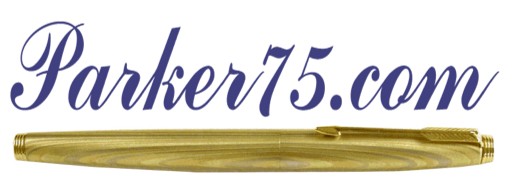ASK THE EXPERTS: TIPS
FROM THE PARKER 75 GUYS
Copyright © 2005 Don Fluckinger
| Note: |
This article
was published in the
Winter/Spring 2005 issue of Erano's Quarterly Pen Review by Paul Erano,
and used here with the permission of both the author and publisher. A
subscription newsletter, EQPR can be ordered for $25 per year using this
printable subscription form. |
Many collectors consider the
Parker 75 a modern pen, lumping it in with modern Duofolds and Montblancs.
Interestingly, this pen is really more of a throwback to the heyday of the
Parker 51 and Sheaffer Balance, in that there are more than 60 nib variations
out there to choose from, ranging from the needlepoint all the way up to the
executive broad.
Parker 75s come in a host of
trim lines, from the classic "Ciselé," the silver cross-hatched
version that's what most collectors probably picture when they hear the words
"Parker 75," all the way to rare prototypes or limited editions that
contain things like silver recovered from a Spanish galleon or even moon dust.
Lih-Tah Wong hosts
Parker75.com, a Web site devoted to the Parker model made from 1963 to 1993. We
sat down with Wong and nationally known 75 expert Lee Chait, Wong's most
frequent site contributor, to solicit some advice on what to look for when
buying 75s at pen shows, antique shops, and online.
Inspect the sections
Collectors looking to add a Parker 75 to their collection can be thankful
that, like the Parker 51, the 75's a sturdy pen. Like vintage Sheaffer pens, 75s
are well-built, and because so many have survived, they can be bought for as
little as $60 for "daily writers" and $75 for collection-worthy pens
in excellent condition.
The parts generally come intact, and over the
years, our experts say, if any part has a problem it's the section. Threads get
stripped, or sections wear out, crack, or shrink on occasion. Feeds sometimes
break off, too.
When inspecting a 75, make sure there's a solid fit between cap and section
or plan on getting a new section — and those are getting scarcer, Wong says.
He adds that sometimes ill-fitting caps and sections can be a simple matter of
flattened springs. An advanced collector can disassemble an otherwise intact
section-clutch ring set and re-bend the clutch spring to make it fit tightly
again.
Another pressure point during use is inside the pen, where the cartridge
meets the section. Be sure to open it up and inspect this junction.
"Sometimes when people are trying to clean out the nib/section
assembly and try to pull off the nib, the thin tube that extends into the
section may break because they exert a bending force during the two-handed
operation," Wong says. "Other times, while inserting a converter into
the section, they may break or damage the nipple upon which the convert seals,
which causes ink to leak."
Look for dings, bite marks
Because 75s come with metal bodies, dents happen. Chait says that no
particular spot on the 75 is more vulnerable than others, so it's wise to look
over all of a pen carefully.
"You've really got to work hard to dent something like a 75,"
Chait says. "You either have to drop it, or push something against it real
hard ... such as packing in a suitcase — but it's not something that's going
to affect the way it writes."
Other problems to look for include the usual
teeth marks and, on plated pens, brassing or chips in the plating. Check the
converter, too, as the aerometric filler's sac can sometimes be worn out.
The silver Ciselé pens are an interesting case. Should collectors care
about whether they've been polished or whether the black grid lines are present?
The short answer is no, because tarnish will work its way back into the grooves
on its own. Collectors can hasten the blackening process following the
directions on Wong's site.
"This is a matter of
individual preference," Wong says. "For myself, I don't like the grid
lines to be that dark; instead I would rather just let silver oxidation build up
over time. Then as I polish the pen, the oxidation in the grid lines will
remain."
Nibs
Connoisseurs of exotic nibs will find the Parker 75 a collecting challenge:
Not only are there many variations in the nib points — from needlepoint to
accountant tip to stubs all the way to the "executive extra-broad"
signature tip-but also they come in both 14K and 18K gold. The older nibs, Chait
points out, are numbered, which makes it much easier to identify them. Beyond
the basic "medium" and "Fine" nibs, the most popular nibs
among collectors right now seem to be the medium stub and the executive extra
broad, he adds.
The above list is just the tip of (the iceberg: Other tips include italics,
Arabics, and obliques for lefthanders and righties alike. Expect to pay a little
more — up to $60 extra — for some of the exotic nib styles at pen shows,
Chait says. The numbering in the 18K series is different from that in the 14K,
which complicates identification.
When selecting a nib style on which lo concentrate in your hunt for 75s,
"it all comes down to personal preference, how you write and what you want
to write with," Chait says. "Do you want a car with air7 conditioning,
or automatic [transmission] and air conditioning?"
Rarities
Hunting down Parker 75s "in the wild" — outside of the pen
hobby, in antique shops, flea markets and estate auctions-can he like a treasure
hunt, literally: Special edition 75s included pens made from sunken treasure
from a Spanish galleon or brass recovered from the RMS Queen Elizabeth.
Other limited editions included the 1976 "Americana" pewter pen,
which features a relic from Independence Hall, and extreme rarities such as pens
made for the George H. W. Bush and Mikhail Gorbachev signing of the 1990 Nuclear
Test Ban treaty.
These pens, as well as prototypes, command a premium in the collector
market. While limited editions are usually clearly marked in commemorative
packaging, prototypes can be identified by their lack of markings.
"I've bought
prototypes from employees of
Parker who have left the company, from the model shop and stuff like that,"
Chait says. "'They have no Parker markings on them. They were made from
scratch."
Get knowledge and ask questions
Chait and Wong both advise
collectors to ask questions of sellers before they buy pens. Especially on eBay,
when pictures can't answer even such basics as, "Does the pen work?"
The best place to learn more about the pen
and the wealth of nib choices available,
these two say, is at their Parker75.com Web
site. They may be biased in that regard, but the site does have deep reference
data, including detailed pictures of prototype pens they've seen or own.
Collectors can learn ii about the different models Parker made — from the
Ciselé crosshatch to vermeil and titanium pens — and see what kind of 75 they
want to concentrate on acquiring.
But beware: After getting your first 75, you might get sucked into getting
more. Like Chait and Wong, a passing interest could turn into a decade-long
obsession that leads you to rare nibs, titanium models, and 24K gold-plated pens
used to sign international weapons bans.
In fact, Chait says, he's had to winnow his collection
down to pens of "historical significance,"
which meant he kept the prototypes,
the limited editions, the treaty pens he had,
and some others such as a few rainbow gold pens new in box.
"The ones I sold didn't have historical significance," he
says. What did he do with the proceeds? "I bought a car."









